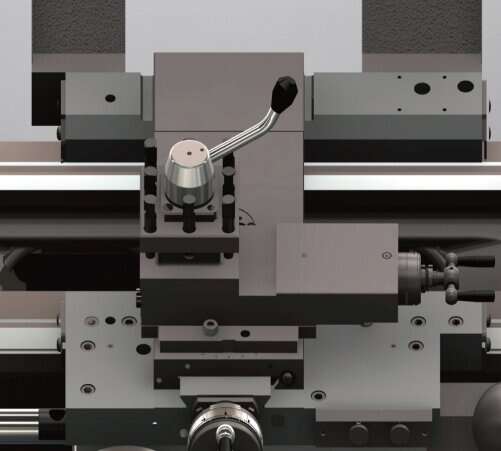Understanding the Difference: Flat Bed CNC Lathe vs. Slant Bed CNC Lathe
November 06,2024
When diving into the world of CNC lathes, you might come across terms like "flat bed CNC lathe" and "slant bed CNC lathe." These are two primary types of CNC lathes used in manufacturing and machining, each with its own set of advantages and applications. In this blog, we'll explore these two types of CNC lathes, comparing their features, benefits, and ideal use cases to help you understand which one might be the best fit for your needs.
What is a CNC Lathe?
Before we dive into the specifics of flat bed and slant bed CNC lathes, let's start with a brief overview of what a CNC lathe is. A CNC lathe, or Computer Numerical Control lathe, is a machine tool used for shaping metal, plastic, or other materials by rotating the workpiece against a cutting tool. The "CNC" part means that the machine is controlled by a computer, which allows for high precision and the ability to execute complex designs.
Flat Bed CNC Lathe
A flat bed CNC lathe, as the name suggests, has a horizontal bed that is flat and parallel to the ground. This design is one of the most traditional configurations for CNC lathes.
Features of Flat Bed CNC Lathes
Stability and Rigidity: The flat bed design provides a stable and rigid base, which is crucial for precision machining. This rigidity helps in achieving high accuracy and consistent results.
Ease of Setup: With its flat bed, setting up and aligning the workpiece can be straightforward. This can be particularly advantageous for larger or heavier parts that need to be securely fixed.
Cost-Effectiveness: Flat bed CNC lathes tend to be more cost-effective compared to their slant bed counterparts. They are often less expensive to manufacture and purchase, making them an attractive option for smaller shops or those just starting out.
Applications
Flat bed CNC lathes are versatile and can handle a wide range of machining tasks. They are particularly useful for large, heavy workpieces and are often found in industries where such materials are common. Their design also makes them suitable for tasks that require a lot of manual adjustments.

Slant Bed CNC Lathe
The slant bed CNC lathe features a bed that is angled, or slanted, rather than flat. This design offers several unique benefits and is commonly used in various modern machining applications.
Features of Slant Bed CNC Lathes
Chip Removal: The slanted design of the bed helps with efficient chip removal. Chips and debris naturally fall away from the work area, reducing the risk of buildup and ensuring a cleaner work environment.
Improved Access: The angled bed makes it easier for operators to access the work area, which can streamline the setup process and reduce the time needed for tool changes and adjustments.
Enhanced Cutting Precision: The slant bed design can offer better stability during cutting operations, which translates to improved precision and surface finish. The reduced distance between the cutting tool and the workpiece also contributes to this increased accuracy.
Automatic Tool Change: Many slant bed CNC lathes are equipped with automatic tool changers, which can significantly speed up production processes and reduce manual intervention.
Applications
Slant bed CNC lathes are ideal for high-speed, high-precision machining tasks. They are commonly used in industries where small to medium-sized parts need to be produced quickly and accurately. Their efficient chip removal and improved access make them a popular choice for automated production lines and high-volume manufacturing.
Comparing Flat Bed and Slant Bed CNC Lathes
When choosing between a flat bed CNC lathe and a slant bed CNC lathe, it's important to consider several factors, including the specific needs of your manufacturing process, the types of materials you work with, and your budget.
Precision and Stability
Both types of lathes offer high precision, but the slant bed CNC lathe may have a slight edge in terms of cutting accuracy due to its design. The flat bed CNC lathe, however, provides excellent stability and rigidity, which is crucial for larger or heavier workpieces.
Chip Management
If chip removal is a significant concern for your operations, the slant bed CNC lathe has a clear advantage. Its angled design ensures that chips are efficiently directed away from the work area, reducing the need for manual cleaning and maintenance.
Access and Setup
The flat bed CNC lathe offers ease of setup and alignment, which can be beneficial for larger parts or when frequent changes are needed. On the other hand, the slant bed CNC lathe provides better access to the work area and can streamline the setup process, particularly when equipped with automatic tool changers.
Cost and Budget
In terms of cost, flat bed CNC lathes are generally more budget-friendly compared to slant bed CNC lathes. If you are looking for a cost-effective solution and are working with larger or heavier parts, a flat bed CNC lathe might be the better choice.
Conclusion
Both flat bed CNC lathes and slant bed CNC lathes have their own unique advantages and are suited to different types of machining tasks. Understanding the differences between these two types of CNC lathes can help you make an informed decision based on your specific needs and requirements.
Whether you choose a flat bed CNC lathe for its stability and cost-effectiveness or a slant bed CNC lathe for its efficiency and precision, investing in the right CNC lathe can significantly impact the quality and efficiency of your manufacturing processes. By considering factors such as chip removal, access, precision, and budget, you can select the CNC lathe that best fits your needs and helps you achieve your production goals.
In the end, the choice between a flat bed CNC lathe and a slant bed CNC lathe is about matching the right tool to the job. Both have their place in the world of machining, and understanding their strengths and applications will help you make the best decision for your specific needs.